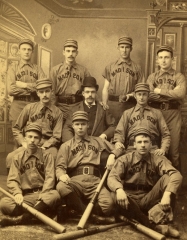The commencement season, as always, was the highlight of the academic year. After 1872, it came in June rather than August as had been the old custom. There were separate graduation exercises of each of the three divisions of the University, as well as the usual annual meetings, class reunions, and various events of the College Senior class. Aside’ from the actual graduation, perhaps, the Seniors found Class Day the most attractive occasion of the week. At it they conducted their own program of orations, class history, prophecy, poem, and presented their “class gift”
to the University. The Class of 1882 introduced the practice of sending rather elaborate commencement invitations to their friends while the Class of 1889 daringly innovated a “Senior Ball.”
For the College graduation, the commencement procession formed at the Baptist Church and marched down Broad Street and up the Hill to Alumni Hall to the third floor auditorium where the exercises took place. By the late ’70’s members of the Junior Class had assumed the duties of marshalls. A band, hired from Utica or Syracuse, led the procession which consisted of the University and Education Society trustees, faculty, classes of the Seminary, College and Academy (or such of the students as chose to remain on campus at the year’s end), alumni, and citizens of Hamilton. The program of speeches by the whole graduating class remained unchanged from the earlier period. Throwing bouquets to the graduates as they came to the platform to receive their diplomas was given up in 1883 and after 1890 the degrees were no longer conferred in Latin. Following the exercises came the Alumni Dinner and the concluding event, the “President’s Levee,”
at his home.
Alumni ties to the University and each other were fostered not only by the Alumni Association but also by regional organizations. One was formed in New York City in 1872 and later others were to be found in, Boston, Philadelphia, and Chicago. At the various annual meetings of the Baptist denomination the Madison alumni arranged to foregather. At all of these occasions it was usual for a faculty member to bring greetings and news from the campus. As a means of building alumni loyalty one student suggested in 1885 that graduates assist the faculty in finding jobs for the increasingly large proportion of non-ministerial members of each senior class. Alumni interest in University affairs was reaching the point in 1886 where some were urging that they have representation on the Board of Trustees. This development was to be







